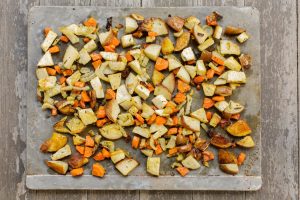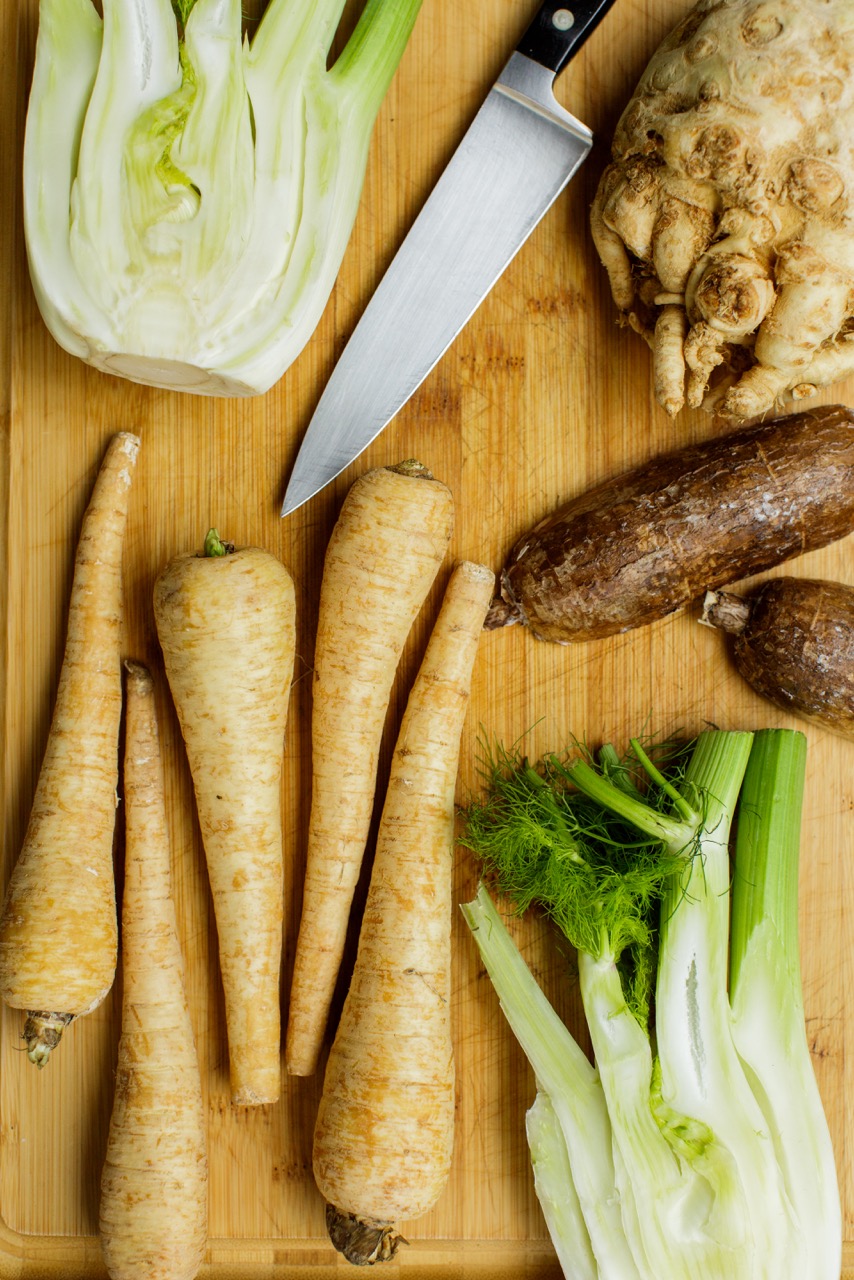They’re dull in color and have strange “eyes” or shoots growing out of them like antennae. They are often as bulbous as the nose in a caricature. They grow underground, for goodness’ sake.
Maybe we can all admit that they aren’t the prettiest of all the produce on display. Still, root vegetables have a lot going for them. Because they absorb water and nutrients to feed the rest of their plant, they are some of the most nutrient-rich vegetables out there. They are low in calories, high in antioxidants, and most of them can be consumed in their entirety, including their skins, stems and leaves. Let’s go beyond the ubiquitously boring potato and carrot and explore how to transform a few “ugly-duckling” roots into the homecoming court of your fall table.
Probably the weirdest looking of the bunch, celeriac, also known as celery root, has a brown, knobby skin and white flesh. It is harvested in the fall and winter months. When eaten raw, its crunchy texture and flavor is similar to celery stalks, but that flavor grows slightly sweeter and nuttier when it is cooked. High in fiber, vitamins C and K, and potassium, celeriac can be a great lower-carb alternative to potatoes in soups, stews and casseroles, or even simply mashed. The leaves can be used in a salad or as a garnish.

Another unfortunate-looking root is cassava. Also known as yuca, this starch is ground to become the more-familiar tapioca. But after it is completely peeled and its tough, string-like fiber is removed, its flesh works very similarly to a potato. Because it is high in resistant starch, research suggests it can act as a probiotic. It is also high in vitamin C and fiber as well as saponins, which are said to reduce bad cholesterol. This high-carb vegetable should never be eaten raw and can rot pretty quickly, so it should be used right away or pre-cut and frozen.
If you’re sick of carrots, try their skinny pale relatives, parsnips (even in a cake, as you see done here). Parsnips are sweeter than their orange cousins, but in cooking, they are just as versatile. Grate them into salads and slaws, use them in soups and stews, or make them into a puree. Like the other vegetables mentioned here, parsnips are high in fiber, low in calories and are a good source of vitamin C and manganese, which is essential for bone health. Look for smaller ones, as larger ones can become fibrous and woody.

Fennel – with its white bulb, pale green stalks, and dark green fronds – is familiar to many because its seeds are used to flavor Italian sausage. In fact, this entire plant is edible and tastes mildly of licorice, but that flavor can be softened by sautéing, roasting, or grilling it. Fennel adds a nice crunch to salads and slaws, and pairs very nicely with seafood. Try substituting it for celery in your favorite recipe for a more unique flavor. Use its feathery fronds as you would parsley or dill, to add flavor or as a garnish. It is high in fiber, potassium, folate, and vitamin C, and has anti-inflammatory properties.
The recipes included here act as fairy godmother to these unusual roots. My own Rosemary Root Veggie Pot Pie is weeknight-simple and a Meatless Monday favorite. Personal chef and caterer Chef Lise Jaeger of Chef for Hire, LLC (ctchefforhire.com) in Middletown offers up her Latin-Style Cassava and Potato Stew, which she famously pairs with roast pork shoulder. The Olive Oil, Parsnip and Apple Cake is featured on the award-winning farm-to-table menu at Bistro on Main in Manchester (bistro-on-main.com).

Some spices – like ginger, turmeric and cardamom – are related to root vegetables, so “dig” in and experiment by adding those for added flavor and nutrition. And remember to buy local! Connecticut farmers harvest root vegetables in fall, and there are plenty of winter farmers’ markets throughout the state.
Amy S. White is a teacher, food writer, and line cook in eastern Connecticut. This fall she can be found “rooting” around her local farmers’ markets to find the freshest ingredients for her seasonal recipes. For more about Amy, go to amyswhite.com.
Photographed by ALLEGRO ANDERSON





More Stories
Wing It This Summer
Spring Pastas
Connecticut Chefs and One Bartender